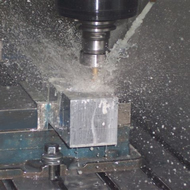Preventing Health Hazards from Metal Working Fluids
Posted on by
More than 100 million gallons of metal working fluids (MWFs) are produced every year, and more than 1 million employees are exposed to these MWFs. The National Institute for Occupational Safety and Health (NIOSH) has conducted more than 70 on-site health hazard evaluations (HHEs) of facilities with occupational exposures to MWFs or mineral oil aerosols. Although NIOSH issued guidance on recommended exposure limits (RELs) and controls for MWFs in 1998, we continue to find employees exposed to airborne concentrations of MWFs above the RELs and employees with respiratory and skin problems of the types associated with MWF exposures.
MWFs are used to lubricate, cool, prevent corrosion of, and remove chips from tools and metal parts during grinding, cutting, or boring operations. There are several types of MWFs: straight or soluble oils, semisynthetic oils, and synthetic oils. Exposures to MWFs can occur through inhaling aerosols, skin contact with contaminated surfaces, and splashing of fluids. Employees who have been exposed to MWFs often report skin disorders (skin irritations, oil acne, and rashes); eye, nose, and throat irritation; and respiratory symptoms (cough, asthma, or other breathing problems).
In 1998, NIOSH issued RELs of 0.5 mg/m3 for total MWF particulates and 0.4 mg/m3 for the thoracic particulate mass, as a time-weighted average concentration for up to 10 hours per day during a 40-hour work week. (The NIOSH Criteria Document can be found at http://www.cdc.gov/niosh/98-102.html.) NIOSH also stated that, where possible, aerosol MWF concentrations should be kept below the REL. This level will be protective for most workers exposed to MWF aerosols. There is no exposure limit for dermal exposure to MWFs at this time. Dermal contact should be limited to prevent allergic and irritant skin reactions.
Effective fluid management guidelines and exposure control measures exist, yet we continue to see ineffective workplace practices and conditions. Between 1998 and 2006, NIOSH received 23 HHE requests concerning exposure to MWFs. The results of the 23 NIOSH evaluations indicated that 13 of the 15 facilities where air samples were collected had MWF air concentrations above the REL. Spirometry (a procedure used to measure lung function) and medical record reviews revealed respiratory symptoms in 13 of the facilities, skin symptoms in 12, findings consistent with occupational asthma in 3, and hypersensitivity pneumonitis in 3.
Although great strides have been made in improving working conditions in facilities that use MWFs, continuing improvements are needed to ensure that all employees exposed to MWFs are not at risk of developing adverse health effects. Many work sites still have inadequate ventilation, poor MWF maintenance, and lack of machine enclosures. These issues combined with inadequate medical surveillance and fluids monitoring exacerbate employee exposure to MWFs. Limitations on access to proprietary information and incomplete Material Safety Data Sheets (MSDS) make it difficult for employers to be aware of potential exposures and therefore unable to provide appropriate protection for their employees. Lack of sufficient information on MSDSs also complicates the search for causative agents when MWF-related health problems arise. It has become evident that health effects may develop in employees whose exposures are below current occupational exposure limits.
NIOSH is working to develop a standardized approach to evaluate exposures, to develop exposure-response relationships, and to provide effective and practical solutions for MWF problems. Working with and through the National Toxicology Program, NIOSH is conducting research on the irritant and allergenic properties of MWFs and is also studying their potential for carcinogenicity. Methods are being developed to characterize, classify, and measure concentrations in solutions, as liquid aerosols and for the volatile components in air, to detect changes in the composition, and to identify biocide concentrations in MWFs.
As we move forward with this research, we pose the following questions to you:
- What are the barriers to implementing guidelines on any of the following issues: fluid maintenance, ventilation, enclosures, training, and recognition of adverse health effects?
- Are you seeing respiratory and skin problems at your facility when MWF exposures are below the REL?
We are also interested in learning about success stories concerning worker safety and health in the MWF industry.
—Nancy Clark Burton, PhD, MPH, CIH; Judith Eisenberg, MD, MS; Stefanie Evans, MA; Manny Rodriguez, MS, CIH, CSP; Loren Tapp, MD, MS
The authors all work in the NIOSH Division of Surveillance, Hazard Evaluations, and Field Studies (DSHEFS), Hazard Evaluations and Technical Assistance Branch (HETAB). Nancy Clark Burton is an industrial hygiene team leader. Judith Eisenberg is a medical officer. Stefanie Evans is a health communications specialist. Manny Rodriguez is an industrial hygienist. Loren Tapp is a medical officer.
References
- Cohen H, White EM [2006]. Metalworking fluid mist occupational exposure limits: a discussion of alternative methods. J Occup Environ Hyg. 3(9):501-507.
- ILMA [2000]. 1999 Volume Survey: Report on the Volume of Lubricants Manufactured in the United States and Canada by Independent Lubricant Manufacturers in 1999. Alexandria, VA: Independent Lubricant Manufacturers Association.
- NIOSH [1998]. Criteria for a recommended standard: occupational exposure to metalworking fluids. Cincinnati, OH: U.S. Department of Health and Human Services, Centers for Disease Control and Prevention, National Institute for Occupational Safety and Health. DHHS (NIOSH) Pub. No. 98-102. [http://www.cdc.gov/niosh/98-102.html]
- NIOSH [2007]. Health hazard evaluation and technical assistance report: HETA 005-0227-3049, Diamond Chain Company, Indianapolis, Indiana. [http://www.cdc.gov/niosh/hhe/reports/pdfs/2005-0227-3049.pdf]
- NIOSH [2008]. Health hazard evaluation report: HETA-2006-0332-3058, evaluation of worker exposures to noise, metalworking fluids, welding fumes, and acids during metal conduit manufacturing, Republic Conduit, Louisville, Kentucky. [http://www.cdc.gov/niosh/hhe/reports/pdfs/2006-0332-3058.pdf]
- OSHA [1999]. Metalworking Fluids: Safety and Health Best Practices Manual. Salt Lake City: U.S. Department of Labor, Occupational Safety and Health Administration. [http://www.osha.gov/SLTC/metalworkingfluids/metalworkingfluids_manual.html]
Posted on by


